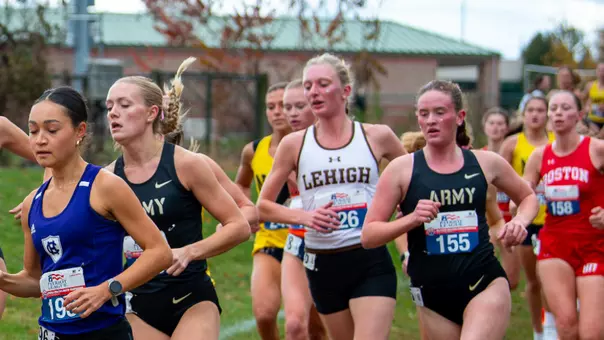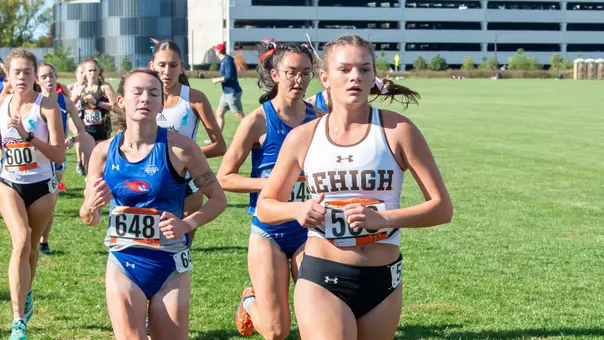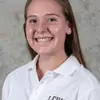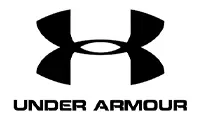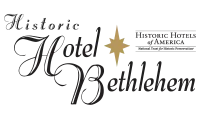
A Trio of Trendsetters
7/30/2019 6:14:00 PM | Women's Cross Country, Women's Rowing, Women's Track and Field, Student Athlete, Features, Intellectual Development
By: Justin Lafleur, Lehigh Sports Communications
Women are minorities in the engineering field. As described in a 2017 Forbes article, "Women only make up 24 percent of the computing workforce - and that number is declining."
That hasn't stopped three Lehigh student-athletes who are going against the grain, paving their path and thriving in the process.
Along the way, Lehigh has supported them every step of the way.
"The female professor whose lab I work in (Professor Lelsey Chow) has always been very open about saying if you ever have a problem as a woman in engineering, or if you ever have a problem with your gender, ethnicity or sexuality, I am here to back you up," said Diana Hammerstone. "You can come to me and I'll fight for you.
"It's definitely moving to know that somebody has my back because people do experience difficulties as women in this field. But I have been lucky enough to not experience anything like that."
In fact, it has been quite the opposite.
All rising seniors, Ashleigh Crawford (bioengineering) and Hammerstone (materials science and engineering) from cross country/track, along with Sarah Boyer (materials science and engineering) from rowing have been empowered to succeed in the engineering field at Lehigh. And all three are on campus this summer, thanks to the prestigious Clare Boothe Luce program, a national program that identifies high-achieving women engineers to conduct advanced-level research.
Here are their stories…
Ashleigh Crawford
 Last fall, Crawford was trying to figure out what she wanted to do post-graduation.
Last fall, Crawford was trying to figure out what she wanted to do post-graduation.
"The options seemed to be either go into the industry or graduate school," she said. "I wanted to branch out and get the experience of working in an academic lab to see if grad school was something I wanted to pursue. That's why I applied for the Clare Boothe Luce scholarship."
Crawford, who has a hand in two projects, was in the lab this past spring semester and will continue her research through next spring semester as part of Dr. Xuanhong Cheng's lab.
"My main project is a microfluidic device (which deals with the behavior of fluids), using a temperate gradient to separate out nanoparticles (small particles)," said Crawford. "Our solution runs through the device, which is set up in between a hot and cold plate. In the end, there are three different channels; one channel is more concentrated, one channel is more dilute and the third channel is in the middle."
Crawford is essentially separating out parts of fluid, ultimately looking to apply the process to exosomes (which emanate from the cells) and mitochondria (the powerhouse of cells).
Like taxis in a city going from building to building, exosomes are small vesicles that communicate between cells.
"We want to find a better way to concentrate the fluids down, but not destroy the solution's components, which the current processes do," said Crawford. "By incorporating this device, we're hoping we can get more concentrated samples of exosomes and mitochondria to be able to study them in the future."
There's a lot of research going into exosomes and their therapeutic abilities, so this process could help salvage them.
"The microfluidic device has been worked on for a few years and we are adapting it to different solutions," said Crawford. "In the past, it was used to separate out viruses such as HIV, whereas now, we're trying to have it separate out a different biological material."
Another project Crawford had a hand in this past spring was the development of a lateral flow device for sickle cell anemia (a condition in which there aren't enough healthy red blood cells to carry oxygen throughout the body).
"The device is very similar to a pregnancy test strip, but would detect sickle cell anemia," said Crawford. "You put a blood sample on the test strip."
Crawford isn't focusing on that project over the summer, but other students are also working on it and continuing to push it forward.
"I still get to check in and see what progress is being made," she said. "Then in the fall, I'll jump back into both of these projects."
Diana Hammerstone
While Crawford wasn't sure if she was interested in research, Hammerstone has had a longer-standing passion for it.
"I started research with Professor (Lesley) Chow last summer because I had taken her class and was interested in her lab," said Hammerstone. "She was gracious enough to accept me. I started with her last summer, and she suggested I apply for the Clare Booth Luce program."

Like Crawford, Hammerstone is working on multiple different projects and with several people, including men's cross country/track and field graduate John Tolbert.
"Our lab works with modular biomaterials (materials that have been engineered for a medical purpose) for tissue engineering," she said. "I'm figuring out how we do this with a greater number of materials, so we can meet the needs of different applications. I work mostly with 3D printing with polymers (large molecules with repeated subunits). I'm helping to figure out the properties of the polymers, which help us figure out how to print with them immediately… rather than trial and error, which takes time."
Essentially, 3D printing is the mechanism used to study the properties of polymers.
"We do solvent cast 3D printing, basically meaning we put polymers in a solution, which is like our ink. Then, we put it in the printer," said Hammerstone. "We later extrude (force out) that solution, the solvent evaporates and we're left with a polymer."
Complex stuff for most people, but for someone like Hammerstone, it's a typical day.
"In an average day, I usually go in and set up a print because they take several hours," she said. "We're printing very small, so we have to go pretty slowly. I set up a print and do other things in the meantime."
Hammerstone is in the midst of plenty other things, including analyzing the mechanical properties of different print architectures, not just the physical properties.
"This is useful for understanding if our prints can effectively serve their purpose in the body," she said. "To do this, I either analyze data or images or go to the electron microscope."
Sarah Boyer
Boyer has had an interest in graduate school for some time, so her summer research is helping her prepare for the future.

"In the fall, I went up to Professor (Lesley) Chow and asked if she had any room in her lab for me," said Sarah. "She said yes; she started this project with another professor, Professor (Helen) Chan and they wanted me to be the undergraduate working on the project."
Boyer is currently using the capabilities of both labs (Professor Chow and Chan) in her daily research.
"The Chow lab 3D prints, so I'm 3D printing metal oxide powders in a polymer ink to make structures," said Sarah. "The goal is to reduce those structures to form high entropy alloys (alloys that are formed by mixing equal or relatively large proportions of five or more elements). Basically, I'm 3D printing metal oxides, then you put it in an 'oven', it gets rid of the oxygen and you're just left with a metal structure."
Speaking of structure, what type of structure do Boyer's days consist of?
"A typical day includes making inks, which takes 48 hours to be fully mixed," she said. "Around two days before, I make an ink. If I have time scheduled at the printer, I would probably 3D print for around five hours and try all my different inks. My goal right now is to find an ink I'm able to print that has the most amount of oxide in it. I'm trying a bunch of different inks to maximize the amount of powder. It's a lot of trial and error currently, which means a lot of 3D printing."
Boyer's end goal is to find a new way to construct high entropy alloys.
"High entropy alloys are new types of alloys that have very interesting properties and contradict things that everyone believed were true in material science," she said. "They're usually created through a casting process, but we're trying to create a new manufacturing way to make different combinations of these alloys."
Motivated To Succeed
Crawford, Hammerstone and Boyer may be working on different labs, but there are plenty of common themes between everyone.
Most importantly, each are motivated individuals who have found an area of passion.
It's showing.
"It doesn't feel like I'm at a job," said Boyer. "I'm working 9 a.m. to 5 p.m., but it doesn't feel tedious or boring. I believe it's the same with athletics. There are definitely points when it's hard, but I still love what I'm doing so it makes everything worth it."
These student-athletes have learned that whether it's in the classroom, lab or competing in athletics, hard work and success are highly correlated.
"You get out of cross country/track what you put in, and it's the same thing with research," said Hammerstone. "If you put the hours in, you're going to collect a data set you can use for something. Keep at it and you're going to eventually get the data you need."
All three individuals are getting what they need out of their Lehigh experience, due in large part to the culture within Lehigh Athletics which is devoted to all-around student-athlete growth, on and off the playing field.
"It's nice to have time in the summer to focus on research, but during the semester, Coach (Brian) Conley (rowing) is really good about working with me," said Boyer. "At the end of the semester, I did a talk for the undergraduate material science symposium. It was the same time as practice, so I told him about it and he said of course, we'll just move practice to the morning.
"I really appreciated that."
Crawford and Hammerstone have been appreciative of all their coaches as well, who genuinely care.
"Coach Deb (Utesch) (women's cross country) has been very helpful in my learning process," said Crawford. "I have talked to her a lot about what I want to do post-graduation and she checked in with me a couple times in the fall and again in the spring. If I need to meet with Dr. Chang or someone in the lab and it occasionally needs to be at 5:00 which is when we usually have practice, she has been really flexible."
To be trendsetters as women engineers, it takes a team effort. The student-athletes and coaches are well aware that growth in one area, like research, can lead to lifelong lessons applied to all aspects of life.
"What research and athletics has added is the need to persevere because research doesn't go perfectly all the time, and it takes a long time to get the result you want," said Hammerstone. "Learn to stick with it and know that things will turn out okay in the end."
So far, things have turned out more than okay for Crawford, Hammerstone and Boyer, who have all persevered to get to this point.
They are trendsetters, going against the grain and paving a path for not only themselves, but also every female who aspires to be an engineer.

Women are minorities in the engineering field. As described in a 2017 Forbes article, "Women only make up 24 percent of the computing workforce - and that number is declining."
That hasn't stopped three Lehigh student-athletes who are going against the grain, paving their path and thriving in the process.
Along the way, Lehigh has supported them every step of the way.
"The female professor whose lab I work in (Professor Lelsey Chow) has always been very open about saying if you ever have a problem as a woman in engineering, or if you ever have a problem with your gender, ethnicity or sexuality, I am here to back you up," said Diana Hammerstone. "You can come to me and I'll fight for you.
"It's definitely moving to know that somebody has my back because people do experience difficulties as women in this field. But I have been lucky enough to not experience anything like that."
In fact, it has been quite the opposite.
All rising seniors, Ashleigh Crawford (bioengineering) and Hammerstone (materials science and engineering) from cross country/track, along with Sarah Boyer (materials science and engineering) from rowing have been empowered to succeed in the engineering field at Lehigh. And all three are on campus this summer, thanks to the prestigious Clare Boothe Luce program, a national program that identifies high-achieving women engineers to conduct advanced-level research.
Here are their stories…
Ashleigh Crawford
 Last fall, Crawford was trying to figure out what she wanted to do post-graduation.
Last fall, Crawford was trying to figure out what she wanted to do post-graduation."The options seemed to be either go into the industry or graduate school," she said. "I wanted to branch out and get the experience of working in an academic lab to see if grad school was something I wanted to pursue. That's why I applied for the Clare Boothe Luce scholarship."
Crawford, who has a hand in two projects, was in the lab this past spring semester and will continue her research through next spring semester as part of Dr. Xuanhong Cheng's lab.
"My main project is a microfluidic device (which deals with the behavior of fluids), using a temperate gradient to separate out nanoparticles (small particles)," said Crawford. "Our solution runs through the device, which is set up in between a hot and cold plate. In the end, there are three different channels; one channel is more concentrated, one channel is more dilute and the third channel is in the middle."
Crawford is essentially separating out parts of fluid, ultimately looking to apply the process to exosomes (which emanate from the cells) and mitochondria (the powerhouse of cells).
Like taxis in a city going from building to building, exosomes are small vesicles that communicate between cells.
"We want to find a better way to concentrate the fluids down, but not destroy the solution's components, which the current processes do," said Crawford. "By incorporating this device, we're hoping we can get more concentrated samples of exosomes and mitochondria to be able to study them in the future."
There's a lot of research going into exosomes and their therapeutic abilities, so this process could help salvage them.
"The microfluidic device has been worked on for a few years and we are adapting it to different solutions," said Crawford. "In the past, it was used to separate out viruses such as HIV, whereas now, we're trying to have it separate out a different biological material."
Another project Crawford had a hand in this past spring was the development of a lateral flow device for sickle cell anemia (a condition in which there aren't enough healthy red blood cells to carry oxygen throughout the body).
"The device is very similar to a pregnancy test strip, but would detect sickle cell anemia," said Crawford. "You put a blood sample on the test strip."
Crawford isn't focusing on that project over the summer, but other students are also working on it and continuing to push it forward.
"I still get to check in and see what progress is being made," she said. "Then in the fall, I'll jump back into both of these projects."
Diana Hammerstone
While Crawford wasn't sure if she was interested in research, Hammerstone has had a longer-standing passion for it.
"I started research with Professor (Lesley) Chow last summer because I had taken her class and was interested in her lab," said Hammerstone. "She was gracious enough to accept me. I started with her last summer, and she suggested I apply for the Clare Booth Luce program."

Like Crawford, Hammerstone is working on multiple different projects and with several people, including men's cross country/track and field graduate John Tolbert.
"Our lab works with modular biomaterials (materials that have been engineered for a medical purpose) for tissue engineering," she said. "I'm figuring out how we do this with a greater number of materials, so we can meet the needs of different applications. I work mostly with 3D printing with polymers (large molecules with repeated subunits). I'm helping to figure out the properties of the polymers, which help us figure out how to print with them immediately… rather than trial and error, which takes time."
Essentially, 3D printing is the mechanism used to study the properties of polymers.
"We do solvent cast 3D printing, basically meaning we put polymers in a solution, which is like our ink. Then, we put it in the printer," said Hammerstone. "We later extrude (force out) that solution, the solvent evaporates and we're left with a polymer."
Complex stuff for most people, but for someone like Hammerstone, it's a typical day.
"In an average day, I usually go in and set up a print because they take several hours," she said. "We're printing very small, so we have to go pretty slowly. I set up a print and do other things in the meantime."
Hammerstone is in the midst of plenty other things, including analyzing the mechanical properties of different print architectures, not just the physical properties.
"This is useful for understanding if our prints can effectively serve their purpose in the body," she said. "To do this, I either analyze data or images or go to the electron microscope."
Sarah Boyer
Boyer has had an interest in graduate school for some time, so her summer research is helping her prepare for the future.

"In the fall, I went up to Professor (Lesley) Chow and asked if she had any room in her lab for me," said Sarah. "She said yes; she started this project with another professor, Professor (Helen) Chan and they wanted me to be the undergraduate working on the project."
Boyer is currently using the capabilities of both labs (Professor Chow and Chan) in her daily research.
"The Chow lab 3D prints, so I'm 3D printing metal oxide powders in a polymer ink to make structures," said Sarah. "The goal is to reduce those structures to form high entropy alloys (alloys that are formed by mixing equal or relatively large proportions of five or more elements). Basically, I'm 3D printing metal oxides, then you put it in an 'oven', it gets rid of the oxygen and you're just left with a metal structure."
Speaking of structure, what type of structure do Boyer's days consist of?
"A typical day includes making inks, which takes 48 hours to be fully mixed," she said. "Around two days before, I make an ink. If I have time scheduled at the printer, I would probably 3D print for around five hours and try all my different inks. My goal right now is to find an ink I'm able to print that has the most amount of oxide in it. I'm trying a bunch of different inks to maximize the amount of powder. It's a lot of trial and error currently, which means a lot of 3D printing."
Boyer's end goal is to find a new way to construct high entropy alloys.
"High entropy alloys are new types of alloys that have very interesting properties and contradict things that everyone believed were true in material science," she said. "They're usually created through a casting process, but we're trying to create a new manufacturing way to make different combinations of these alloys."
Motivated To Succeed
Crawford, Hammerstone and Boyer may be working on different labs, but there are plenty of common themes between everyone.
Most importantly, each are motivated individuals who have found an area of passion.
It's showing.
"It doesn't feel like I'm at a job," said Boyer. "I'm working 9 a.m. to 5 p.m., but it doesn't feel tedious or boring. I believe it's the same with athletics. There are definitely points when it's hard, but I still love what I'm doing so it makes everything worth it."
These student-athletes have learned that whether it's in the classroom, lab or competing in athletics, hard work and success are highly correlated.
"You get out of cross country/track what you put in, and it's the same thing with research," said Hammerstone. "If you put the hours in, you're going to collect a data set you can use for something. Keep at it and you're going to eventually get the data you need."
All three individuals are getting what they need out of their Lehigh experience, due in large part to the culture within Lehigh Athletics which is devoted to all-around student-athlete growth, on and off the playing field.
"It's nice to have time in the summer to focus on research, but during the semester, Coach (Brian) Conley (rowing) is really good about working with me," said Boyer. "At the end of the semester, I did a talk for the undergraduate material science symposium. It was the same time as practice, so I told him about it and he said of course, we'll just move practice to the morning.
"I really appreciated that."
Crawford and Hammerstone have been appreciative of all their coaches as well, who genuinely care.
"Coach Deb (Utesch) (women's cross country) has been very helpful in my learning process," said Crawford. "I have talked to her a lot about what I want to do post-graduation and she checked in with me a couple times in the fall and again in the spring. If I need to meet with Dr. Chang or someone in the lab and it occasionally needs to be at 5:00 which is when we usually have practice, she has been really flexible."
To be trendsetters as women engineers, it takes a team effort. The student-athletes and coaches are well aware that growth in one area, like research, can lead to lifelong lessons applied to all aspects of life.
"What research and athletics has added is the need to persevere because research doesn't go perfectly all the time, and it takes a long time to get the result you want," said Hammerstone. "Learn to stick with it and know that things will turn out okay in the end."
So far, things have turned out more than okay for Crawford, Hammerstone and Boyer, who have all persevered to get to this point.
They are trendsetters, going against the grain and paving a path for not only themselves, but also every female who aspires to be an engineer.

Players Mentioned
Season Preview - Women's Basketball
Friday, October 31
Football Blitz
Friday, October 31
2025-2026 Women's Wrestling Season Preview
Thursday, October 30
2025-20226 Lehigh Men's Basketball Season Preview
Thursday, October 30
